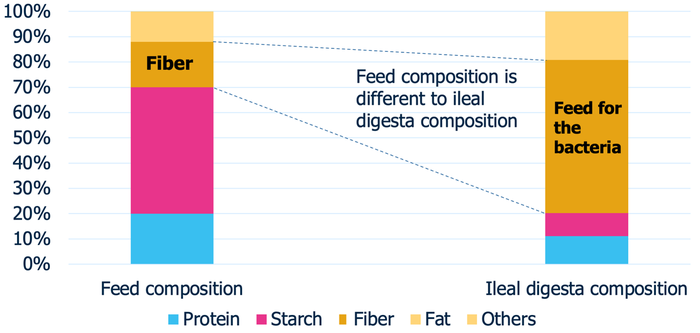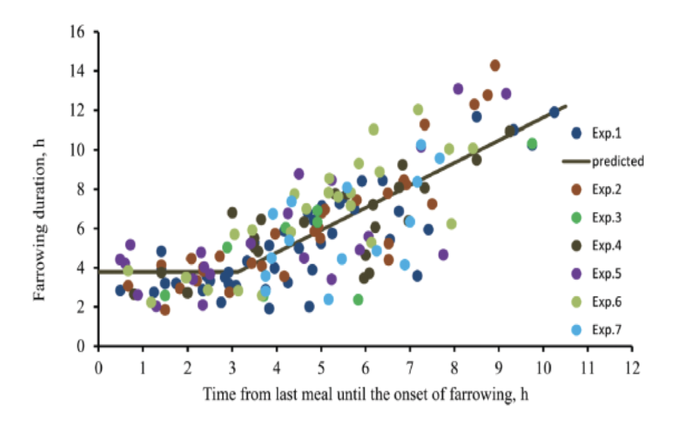Read part two of this three part series, "Inclusion of Fiber in Sow Diets"
June 1, 2021

Sponsored Content
Part 1 of this series introduced the role of fiber on sow performance and discussed methodologies around fiber analyses. This article will discuss the various ways in which fiber works to benefit the sow in terms of performance and farrowing, ensuring piglets have the best start.
Fiber has been shown to play a role in modulating the animals’ hind gut microbiota. Dietary fiber serves as the primary feed substrate for the bacteria in the lower gut (Figure 1). The addition of TDF to gestation diets has been shown to increase the level of butyrate producers, resulting in elevated levels of butyrate in the hind gut as well as total small-chain fatty acids. Furthermore, TDF increases beneficial bacteria in the hind gut such as the genus Christensenellaceae, associated with improved gut health and small-chain fatty acid production (Shang et al., 2019).
Figure 1: Composition of nutrients from feed for the animal and portion remaining after digestion in the small intestine

It has been demonstrated that sows fed greater levels of total dietary fiber (TDF) have a lower incidence of hard feces (7% vs. 1 %; Rameakers et al., 2013) resulting in reduced farrowing time (Olivero et al., 2010). Furthermore, increasing fiber allows nutritionists to permit greater feed intake during gestation while maintaining a suitable body condition scoring. This is an important factor in reducing sow aggression, especially in pen gestation. As a result, sows exhibit more satiety, and at 30 days of gestation, additional dietary fiber resulted in reduced inflammation and decreased stress levels based on serum measurements of cytokines (Zhou et al., 2020). Interestingly, the subsequent piglets from these sows observed a similar reduction in stress levels at birth.
Another consideration for additional fiber intake is the greater size and capacity of the gastrointestinal tract (Jaworski et al., 2015). This is likely the reason why sows can continue to eat close to farrowing, and research has shown that lactation intake is increased when fiber was fed in gestation (Krogh et al., 2015; Sun et al., 2014). This is important in allowing hyper-prolific sows with high piglet numbers to maintain body weight during lactation.
Increased metabolic stress in late gestation and early lactation results in higher oxidative stress that may have negative impacts on pregnancy, especially in high prolific sows. The use of fiber in late gestation has been shown to help mitigate oxidative stress at day 1 of lactation (Tan et al., 2016) and this could explain the performance benefits associated when feeding fiber to sows in gestation and subsequent lactation performance.
One challenge for sows around parturition is the speed of energy depletion, particularly amongst sows with larger litters and longer farrowing times. Research shows that when the time between the last meal consumed to farrowing increases beyond ~4 hours, the farrowing duration gets longer, which can be associated with energy depletion (Figure 2, Feyera et al., 2018). Sows fed a high level of TDF in gestation produce higher levels of small-chain fatty acids and are able to maintain an improved “energy status” than sows fed a diet with less fiber (Serena et al., 2009). This may be associated with production benefits seen at farrowing with sows fed higher levels of TDF.
Figure 2: Impact of time from last meal on farrowing duration (Feyera et al., 2018)

The addition of TDF to the gestation diet also has benefits for piglets; increasing TDF reduces the number of stillbirths, preweaning mortality, and the number of piglets determined to have low viability (Feyera et al., 2014). There are likely two main reasons for these changes. First, the farrowing time is reduced, which reduces the chance of hypoxia for the piglet and also means the piglet will likely receive colostrum sooner. The other reason is the change in the lipid content of the colostrum is greater, thus providing more energy to the piglets to help them get a better start (Loisel et al., 2013; Feyera et al., 2019).
In part 3 we will look more at the effects of fiber types (soluble and insoluble) on sow and piglet performance. To learn more about fiber in sow diets or to receive a copy of the AB Vista fiber guide, please contact [email protected] or your technical representative.
About the Author(s)
You May Also Like


.png?width=300&auto=webp&quality=80&disable=upscale)
